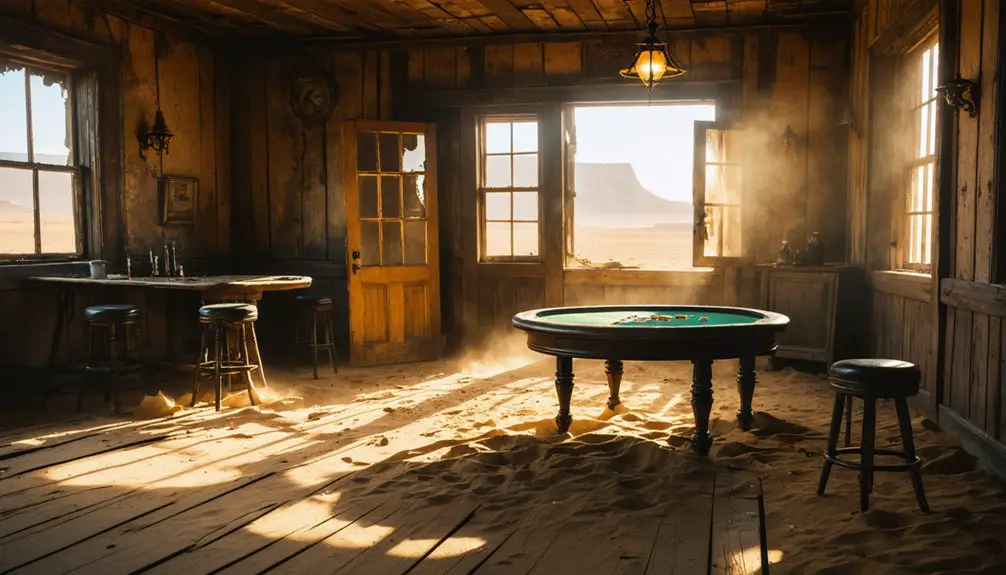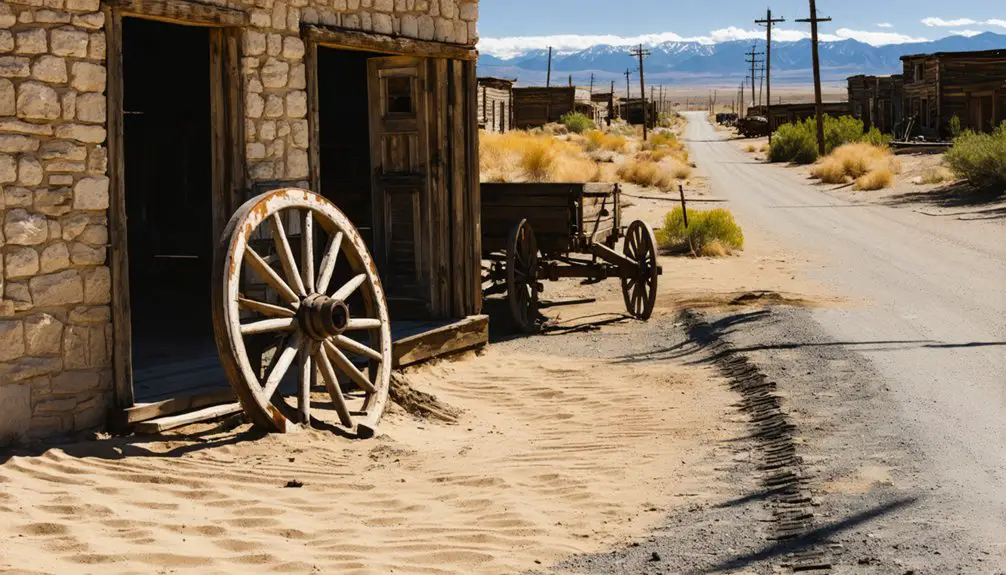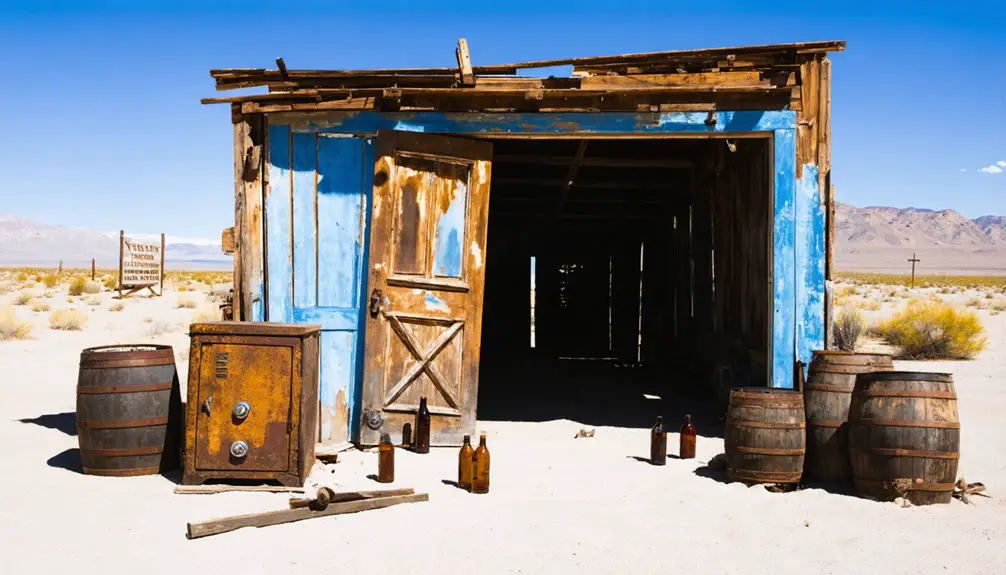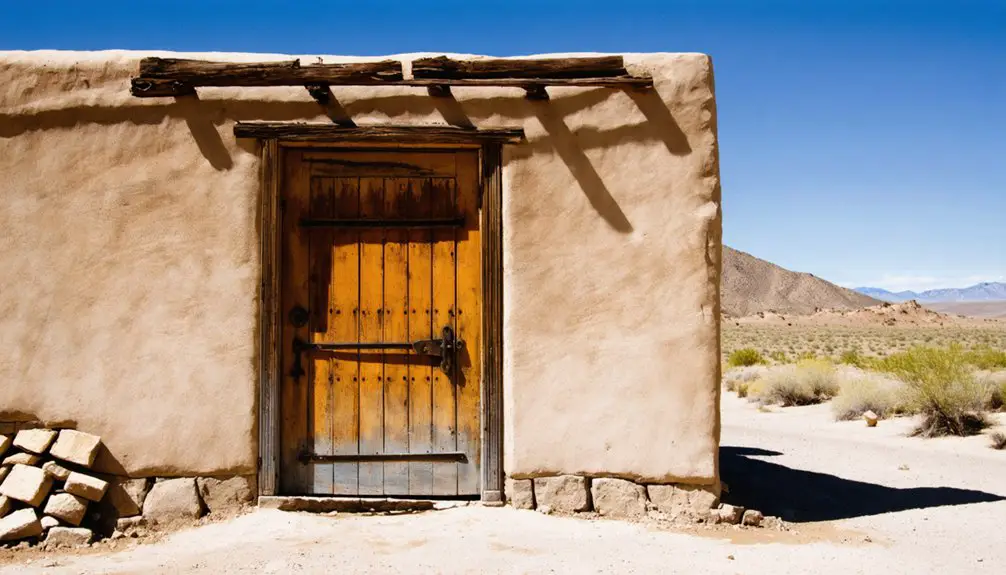You’ll find Belleville’s ghost town ruins nestled in Nevada’s desert landscape, where a once-thriving milling center processed ore from 1873 to 1894. The Northern Belle Mining Company established twin 20-stamp mills here, attracting 800 residents at its peak. The town featured seven saloons, a railroad depot, and a vibrant social scene before water disputes and economic shifts led to its abandonment. Today, stone foundations and scattered artifacts tell a compelling story of boom-and-bust frontier life.
Key Takeaways
- Founded in 1873 as a milling center by Northern Belle Mining Company, Belleville processed ore with twin 20-stamp mills during Nevada’s mining boom.
- The town peaked at 800 residents with seven saloons, featuring a railroad connection and thriving social scene despite frequent violence.
- The Carson and Colorado Railroad’s arrival in 1881 boosted Belleville’s prosperity as a major ore processing hub.
- Belleville’s decline began when Candelaria’s water pipeline redirected ore processing, leading to the post office’s closure in 1894.
- Today, stone mill foundations, crumbling walls, and scattered artifacts remain among desert sage as evidence of this once-bustling mining town.
The Birth of a Milling Town
Unlike most Nevada boomtowns that sprouted around mines, Belleville emerged in 1873 as a dedicated milling center when the Northern Belle Mining Company established a 20-stamp mill to process ore from Candelaria.
You’ll find that Belleville’s mining techniques revolutionized the region’s ore processing capabilities. The first mill began crushing ore in March 1875, producing its initial bullion shipment worth $9,200 the following month. A growing sporting district emerged, complete with breweries and gambling establishments.
When ore volumes exceeded capacity, a second “Upper” mill started operations in August 1876, just 16 months after the first.
The town’s community growth centered entirely around these milling operations, breaking from the typical mine-focused settlements of the era.
Belleville stood apart as a rare processing hub, its entire existence revolving around the mills rather than mines themselves.
While other towns dug for riches, Belleville’s identity was forged in the processing of others’ precious metals, supported by abundant water resources that proved essential to its operations. The arrival of the Carson and Colorado Railroad in 1881 further enhanced the town’s milling capabilities.
Life in the Northern Belle Era
During Belleville’s peak years in the early 1880s, you’d find the town bustling with up to 800 residents going about their daily routines of operating stamp mills, running businesses, and working the railroad terminal.
You could witness the town’s wild character through its seven saloons, frequent shootouts, and lively gambling scene, while cultural pursuits like the magicians’ club and jockey races added unexpected sophistication.
The Northern Belle Mine’s profitable ore processing operations brought economic prosperity to the town, as evidenced by the $9,200 first bullion shipment and the diverse array of businesses that sprung up to serve the population. Two local newspapers, The Self Cocker and Tarantula, kept residents informed of the latest happenings around town. Water scarcity posed significant challenges for the mining operations, with prices reaching one dollar per gallon in 1879.
Mining Town Daily Routines
Life in Belleville revolved around the rhythmic pounding of stamp mills, as the Northern Belle Mine‘s daily operations dominated the town’s economic and social fabric.
You’d find mill hands, blacksmiths, and assay workers bustling through their shifts, while the telegraph office buzzed with mining updates and market prices.
Your daily routines would’ve included dodging ore wagons on dusty streets and dealing with the constant noise of mining operations.
You might’ve visited the doctor for work injuries, grabbed supplies at local shops, or caught up on news at the express office.
After work, you could’ve joined the amateur magicians’ club or watched horse races organized by the jockey club.
But you’d need to stay alert – gunfights and drunken brawls weren’t uncommon in this bustling frontier town of 500 residents.
Wild West Social Scene
Beyond the daily grind of mining operations, Belleville’s social scene pulsed with Wild West energy through its network of seven saloons, bustling gambling halls, and unique entertainment venues.
You’d find social gatherings that ranged from jockey club horse races to amateur magician shows, reflecting the town’s diverse recreational spirit. The Belleville Times kept you informed about community events until 1878, while the telegraph station connected you to the outside world. With the arrival of the Carson and Colorado Railroad in 1882, residents gained even more opportunities for entertainment and social connections. Much like Virginia City’s peak, Belleville drew thousands seeking silver fortune and excitement in the 1870s.
Inside the saloons, you’d witness the raw frontier lifestyle – gambling, drinking, and occasional brawls that characterized the era. Hotels and restaurants offered more refined spaces for socializing, but the town’s untamed nature persisted.
Despite the sometimes violent atmosphere, Belleville maintained a vibrant social fabric that united miners and townspeople in their pursuit of entertainment and connection.
Economic Prosperity Period
As the Northern Belle Mining Company established its presence in 1873, Belleville quickly transformed into a bustling industrial hub centered around its twin 20-stamp mills.
You’d have witnessed remarkable economic impact as the town processed ore from Candelaria, shipping its first bullion bar valued at $9,200 in April 1875.
The community growth was explosive, with the population swelling to 700-800 residents at its peak.
You’d have found a thriving commercial district featuring multiple saloons, hotels, and essential services. The town’s prosperity attracted diverse businesses, from blacksmith shops to breweries, while entertainment flourished through horse racing and magic shows.
When the Carson & Colorado Railroad arrived in 1882, it marked Belleville’s zenith, connecting this industrial powerhouse to wider markets and opportunities.
Economic Boom and Industrial Growth
When Belleville emerged in 1873, the Northern Belle Mining Company established it as a strategic milling hub to process ore from the nearby Candelaria mines. The town’s economic factors centered on advanced milling techniques, with a 20-stamp mill leading the industrial charge.
You’ll find Belleville’s rapid industrial growth reflected in these key developments:
- The first bullion shipment in 1875 valued at $9,200
- Construction of assay offices, express services, and telegraph stations
- Peak population reaching 500 residents by 1881
- Railroad arrival in December 1881 connecting to broader markets
Despite a devastating fire in 1878, the resilient town rebuilt and continued operations. The town’s prosperity hinged on water availability for ore processing, but this advantage wouldn’t last.
When a 27-mile pipeline to Candelaria was completed in 1882, it marked the beginning of Belleville’s eventual decline.
Daily Life and Social Scene

You’d find Belleville’s seven saloons at the heart of daily social life, where mill workers and residents gathered for drinks, entertainment, and occasional brawls.
The town’s “Wild West” reputation emerged from frequent episodes of violence and gunplay, though these were balanced by more organized entertainment like sporting contests and practical jokes among workers.
Hotels and restaurants complemented the saloons as social hubs, creating a network of gathering spots where both permanent residents and transient workers found community amid the challenges of frontier life. By 1875, the town celebrated its first major economic milestone when the first bullion shipment of $9,200 left Belleville.
Saloons and Social Hubs
The bustling social scene of Belleville centered around its seven saloons, which served a population of roughly 500 residents at the town’s peak. The saloon culture fostered vibrant social dynamics where miners, travelers, and locals gathered to drink, gamble, and exchange news about mining operations.
You’d find these crucial elements of Belleville’s entertainment scene:
- A sporting district complete with brewery and gambling houses
- A jockey club hosting spirited horse racing events
- Two hotels and several restaurants complementing the saloons
- A magicians’ club reflecting diverse social interests
Beyond mere drinking establishments, these saloons functioned as crucial business hubs where deals were struck and information flowed freely.
The Carson & Colorado Railroad terminus brought a steady stream of visitors, further energizing the town’s reputation for mixing business with pleasure.
Crime and Wild Behavior
Life in Belleville bore all the hallmarks of a wild frontier town, where three distinct forces shaped daily existence: rampant crime, resource scarcity, and minimal law enforcement.
While crime statistics weren’t formally tracked, the town’s reputation for violence manifested through notorious incidents like the Charles E. Boch murder of bookkeeper Levi Bithly.
You’d find social unrest brewing in the town’s seven saloons, where drunken brawls frequently erupted. The 1876 stagecoach robbery near town highlighted the ongoing risks to bullion shipments. Competition from nearby Candelaria eventually contributed to the social instability.
Water scarcity intensified tensions, with disputes breaking out over even minor resources. In this frontier setting of 400-800 residents, you’d witness a volatile mix of permanent workers and transient miners maneuvering daily life with little official oversight, often resolving conflicts through informal or violent means.
Entertainment Among Mill Workers
Despite the harsh realities of frontier crime, Belleville’s mill workers found numerous outlets for entertainment and social connection throughout their demanding workdays.
After exhausting 10-14 hour shifts, you’d discover a vibrant array of leisure activities and community bonding opportunities across town. Like other mining communities of the era, workers often engaged in gambling and drinking during their off-hours. The social scene centered around these popular diversions:
- Seven bustling saloons serving as primary gathering spots
- An active jockey club organizing regular horse races
- An amateur magicians’ club for those seeking cultural pursuits
- A sporting district complete with gambling establishments
The 1882 arrival of the Carson and Colorado Railroad expanded these entertainment options, connecting workers to regional events while bringing fresh visitors and supplies to Belleville’s hotels, restaurants, and entertainment venues.
The Belleville Times newspaper kept everyone informed of local happenings.
Transportation and Trade Routes

While Belleville’s initial growth centered on ore processing, its transportation infrastructure transformed the town into an indispensable regional hub by 1882.
You’ll find the Carson & Colorado Railroad terminus played a pivotal role in the town’s railroad logistics, facilitating ore shipments from the Northern Belle Mine to Belleville’s 20-stamp mill.
The town’s trade dynamics revolved around a network of facilities supporting commerce, including assay offices, telegraph stations, and blacksmith shops.
You can trace the historic State Route 360, which connected Belleville to US 95, establishing crucial trade corridors.
However, when water pipelines reached Candelaria’s mines in the mid-1880s, you’d see a sharp decline in Belleville’s transportation activity as ore processing shifted away from the town, ultimately contributing to its abandonment by the 1890s.
Notable Events and Local Stories
Throughout Belleville’s brief but turbulent existence, sensational events and colorful personalities shaped the town’s notorious reputation as a quintessential Wild West settlement.
You’ll find that violence and local legends were deeply woven into the fabric of daily life, with ghostly encounters now said to echo the town’s tumultuous past.
- The murder of bookkeeper Levi Bithly by mining secretary Charles E. Boch stands as one of the most documented violent incidents.
- The devastating 1878 fire reshaped the town’s physical landscape but couldn’t extinguish its spirit.
- Seven saloons and numerous gambling establishments hosted frequent shootouts and brawls.
- A thriving jockey club and amateur magicians’ society added unexpected sophistication to the rough-and-tumble atmosphere.
Despite its wild reputation, you’ll discover Belleville maintained vibrant social institutions until its ultimate decline in the 1890s.
Business and Commerce

Beyond its colorful social history, Belleville’s economic foundation rested firmly on its role as a milling powerhouse for the Northern Belle Mine. The town’s business partnerships extended through multiple industries, from milling operations to transportation networks via the Carson & Colorado Railroad.
You’d find a bustling commercial district with hotels, restaurants, and seven saloons serving the population of 500 residents. Trade networks flourished through the express office and telegraph station, while essential services like blacksmith shops and an assay office supported mining operations.
The local newspaper, Belleville Times, kept businesses connected at $7 per subscription. However, when Candelaria developed its water system in the late 1880s, Belleville’s commercial advantage crumbled.
The Town’s Dramatic Decline
After Candelaria developed its water pipeline in 1882, Belleville’s status as a milling powerhouse quickly unraveled. Multiple decline factors converged to transform this once-bustling town into a ghost town within just a decade.
You’ll find these key events marked Belleville’s dramatic downfall:
- The relocation of ore processing to Candelaria eliminated the town’s primary economic purpose.
- Social unrest, including notorious murders and gunfights, drove away potential new residents.
- Population plummeted from 800 to near-zero as businesses shuttered and workers left.
- The post office’s closure in 1894 marked the final blow to civic infrastructure.
While a brief revival occurred in the 1910s for tailing reprocessing, it couldn’t restore the town’s former glory, leaving only stone ruins as evidence of its turbulent past.
What Remains Today

Today’s visitors to Belleville will find three primary remnants of this once-thriving Nevada mining town: a solitary historical marker (HM 154), scattered stone foundations tucked into the hillsides, and a weathered cemetery.
You’ll discover rusted metal fragments and weathered wood pieces across the site, highlighting its historical significance as a bustling mining community.
The foundations reveal where assay offices, telegraph stations, schools, and saloons once stood, preserving the community legacy through their silent testimony.
While accessing the site via SR 360 near US 95, you’ll notice ground depressions marking former cellars and mining pits.
Wild grass now covers much of the area where mills and buildings once operated.
Beyond the marker, there’s little interpretive information, leaving you free to explore and imagine Belleville’s former glory.
Exploring the Ghost Town Ruins
As you explore Belleville’s ruins, you’ll discover stone and brick mill foundations scattered among the desert sage, with several substantial walls still standing as proof of the town’s industrial past.
You can trace the outlines of former building sites where saloons, hotels, and the railroad depot once bustled with activity during the town’s 1870s peak.
Careful observation reveals historic artifacts strewn about the site, offering tangible connections to the daily lives of Belleville’s former residents.
Remaining Building Foundations
The ruins of Belleville reveal a rich architectural legacy through its surviving foundations and structural remnants. As you explore the site, you’ll find impressive foundation preservation that tells the story of this once-bustling mining town.
The architectural significance is particularly evident in the massive industrial structures and residential remains scattered across the landscape.
Key foundation features you’ll discover include:
- Crumbling stone walls and smelter foundations showcasing industrial-scale operations
- Massive dry-stacked stone mill foundations embedded into nearby hillsides
- Depression marks indicating former cellars and residential building sites
- A unique dugout cabin foundation behind the smelter ruins
These stone and brick remains outline Belleville’s original layout, with the industrial district’s robust foundations contrasting against the simpler residential foundation patterns throughout the ghost town site.
Mill Ruins Still Standing
Standing proudly against time’s erosion, Belleville’s mill ruins showcase the town’s industrial legacy through massive stone and brick foundations scattered across the hillsides.
You’ll find impressive dry-stacked stone walls behind the smelter ruins, demonstrating how workers built without mortar in this 1870s ghost town.
The mills, which processed ore from the Northern Belle Mine until the 1890s, left their mark through extensive tailings fields and crumbling processing infrastructure.
While wooden components have largely vanished, the stone foundations have endured Nevada’s harsh desert climate.
Today, you can explore these remnants of early milling technology, including the main smelter complex and worker housing remains.
The ruins tell a story of Belleville’s brief but significant role in regional mining operations, before water pipelines to Candelaria made the town obsolete.
Artifacts Among Desert Sage
Beyond the imposing mill foundations, scattered artifacts and structural remnants paint a vivid picture of Belleville’s bygone era.
You’ll find evidence of the town’s industrial heritage through rusted machinery parts and weathered wooden fragments nestled among the desert sage, showcasing the delicate balance between artifact preservation and desert ecology.
As you explore, you’ll discover:
- Crumbling stone walls and smelter ruins with sophisticated medieval-style curved stonework
- Dry-stacked foundations embedded into hillsides, demonstrating builders’ adaptation to terrain
- Historic cemetery markers providing dates and names amid the sagebrush
- Depressions marking former cellars and building sites throughout the settlement
The site’s rich archaeological context reveals both industrial operations and daily life in this 1870s-1890s mining community, where metal and wood fragments intermingle with wild desert vegetation.
Frequently Asked Questions
What Was the Average Wage for Miners and Mill Workers in Belleville?
Like striking gold, average miner wages sparkled at $2-$4 daily, while you’d see mill worker salaries shine a bit less brightly at $1.50-$3 per day during Belleville’s peak mining era.
Were There Any Native American Settlements or Conflicts Near Belleville?
You’ll find Native American history shows Northern Paiute and Western Shoshone used the area for seasonal camps, though no permanent settlements existed directly in Belleville. Major conflicts weren’t documented at this specific location.
What Was the Primary Source of Drinking Water for Belleville Residents?
You’d have relied on surface water sources like springs and wells, or hauled in water from elsewhere. Mining impacts made water access increasingly difficult without dedicated infrastructure like Candelaria’s pipeline.
Did Any Famous Outlaws or Historical Figures Ever Visit Belleville?
While you might wish for tales of famous gunfighters, there’s no evidence of any notable outlaw encounters or historical visits to Belleville. Local violence came from residents and miners, not legendary outlaws.
What Happened to the Railroad Tracks and Equipment After Belleville’s Abandonment?
You’ll find the railroad history unclear, but likely the tracks were salvaged for scrap and equipment remnants relocated to other Carson & Colorado Railroad locations after Belleville’s economic activities ceased.
References
- http://www.nv-landmarks.com/towns-ab/belleville.htm
- https://kids.kiddle.co/Belleville
- https://www.nevadaappeal.com/news/2019/feb/05/the-story-of-bellevilles-brief-fascinating-history/
- https://forgottennevada.org/sites/belleville.html
- https://www.nevadaghosttownsandmininghistory.com/portfolio-2/belleville
- https://shpo.nv.gov/nevadas-historical-markers/historical-markers/belleville
- https://www.nvexpeditions.com/mineral/belleville.php
- https://westernmininghistory.com/towns/nevada/belleville/
- https://www.youtube.com/watch?v=TLKzthyqD90
- https://www.youtube.com/watch?v=OYLsWH2Q9UM



